Working in Partnership in Health and Social Care: Detailed Report
VerifiedAdded on 2024/05/17
|17
|5034
|403
Report
AI Summary
This report provides a comprehensive analysis of working in partnership within the health and social care sector, focusing on the philosophy, models, and outcomes of collaborative efforts. It examines the importance of communication, collaboration, integration, and cooperation in ensuring quality patient care, referencing the NHS 2005 incident and the Francis Report as examples of partnership failures. The report evaluates partnership relationships, analyzes relevant legislation such as the Health and Social Care Act of 2012, and explores the impact of organizational practices and policies on collaborative working. Furthermore, it discusses potential barriers to partnership working and suggests strategies to improve outcomes for service users, professionals, and organizations. The document emphasizes the need for strong leadership, adherence to fundamental standards, and effective communication to foster successful partnerships and enhance the quality of health and social care services. Desklib offers this document and many more to aid students in their learning.
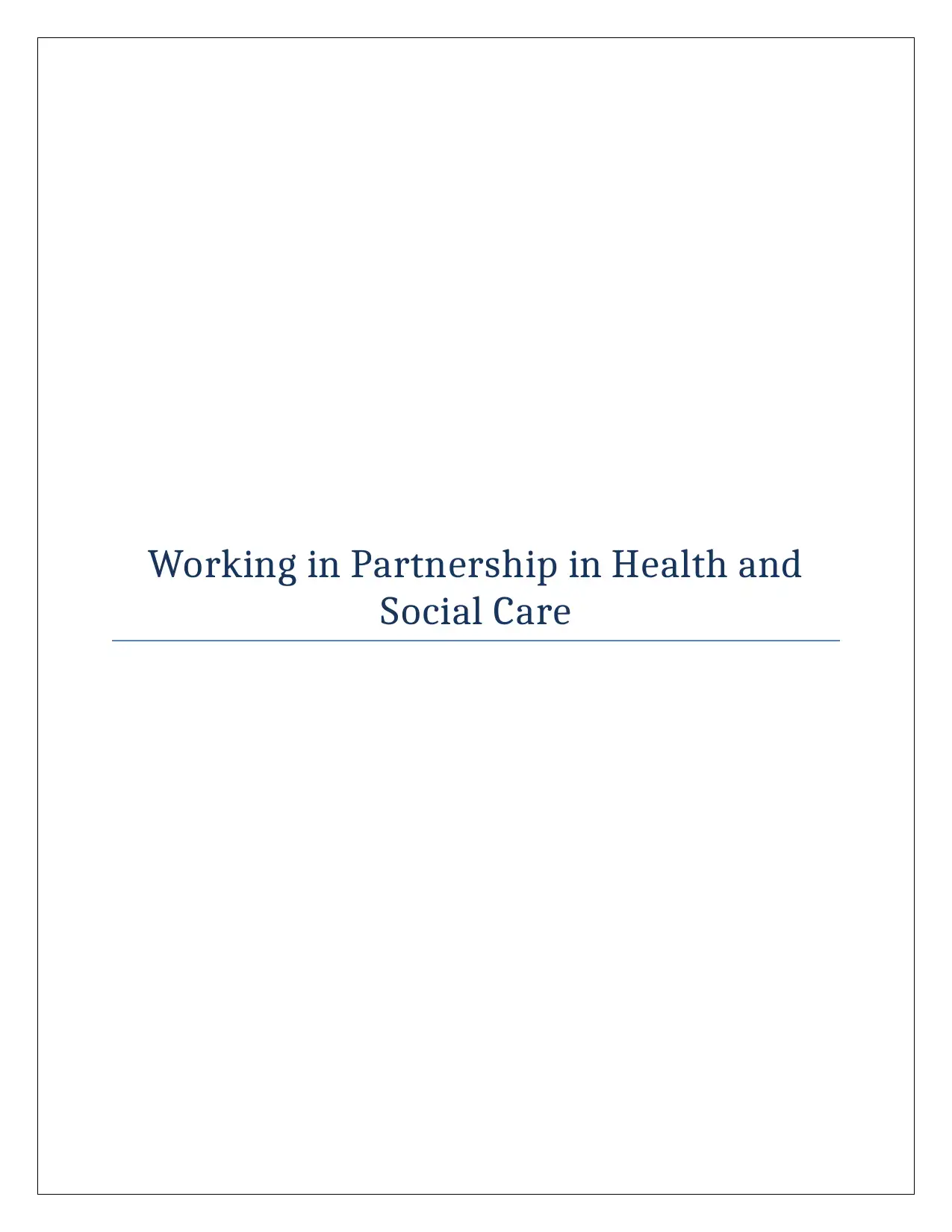
Working in Partnership in Health and
Social Care
Social Care
Paraphrase This Document
Need a fresh take? Get an instant paraphrase of this document with our AI Paraphraser
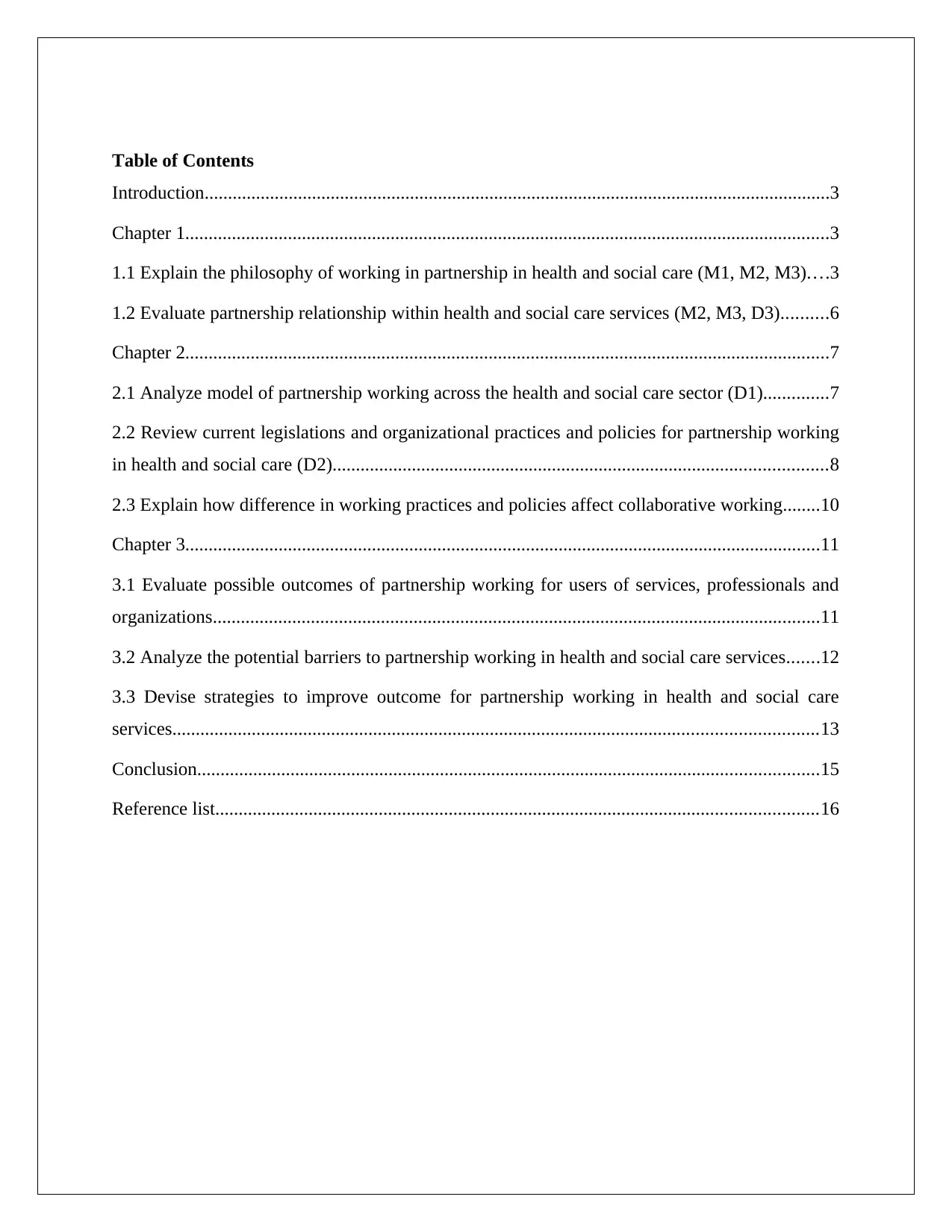
Table of Contents
Introduction......................................................................................................................................3
Chapter 1..........................................................................................................................................3
1.1 Explain the philosophy of working in partnership in health and social care (M1, M2, M3)....3
1.2 Evaluate partnership relationship within health and social care services (M2, M3, D3)..........6
Chapter 2..........................................................................................................................................7
2.1 Analyze model of partnership working across the health and social care sector (D1)..............7
2.2 Review current legislations and organizational practices and policies for partnership working
in health and social care (D2)..........................................................................................................8
2.3 Explain how difference in working practices and policies affect collaborative working........10
Chapter 3........................................................................................................................................11
3.1 Evaluate possible outcomes of partnership working for users of services, professionals and
organizations..................................................................................................................................11
3.2 Analyze the potential barriers to partnership working in health and social care services.......12
3.3 Devise strategies to improve outcome for partnership working in health and social care
services..........................................................................................................................................13
Conclusion.....................................................................................................................................15
Reference list.................................................................................................................................16
Introduction......................................................................................................................................3
Chapter 1..........................................................................................................................................3
1.1 Explain the philosophy of working in partnership in health and social care (M1, M2, M3)....3
1.2 Evaluate partnership relationship within health and social care services (M2, M3, D3)..........6
Chapter 2..........................................................................................................................................7
2.1 Analyze model of partnership working across the health and social care sector (D1)..............7
2.2 Review current legislations and organizational practices and policies for partnership working
in health and social care (D2)..........................................................................................................8
2.3 Explain how difference in working practices and policies affect collaborative working........10
Chapter 3........................................................................................................................................11
3.1 Evaluate possible outcomes of partnership working for users of services, professionals and
organizations..................................................................................................................................11
3.2 Analyze the potential barriers to partnership working in health and social care services.......12
3.3 Devise strategies to improve outcome for partnership working in health and social care
services..........................................................................................................................................13
Conclusion.....................................................................................................................................15
Reference list.................................................................................................................................16
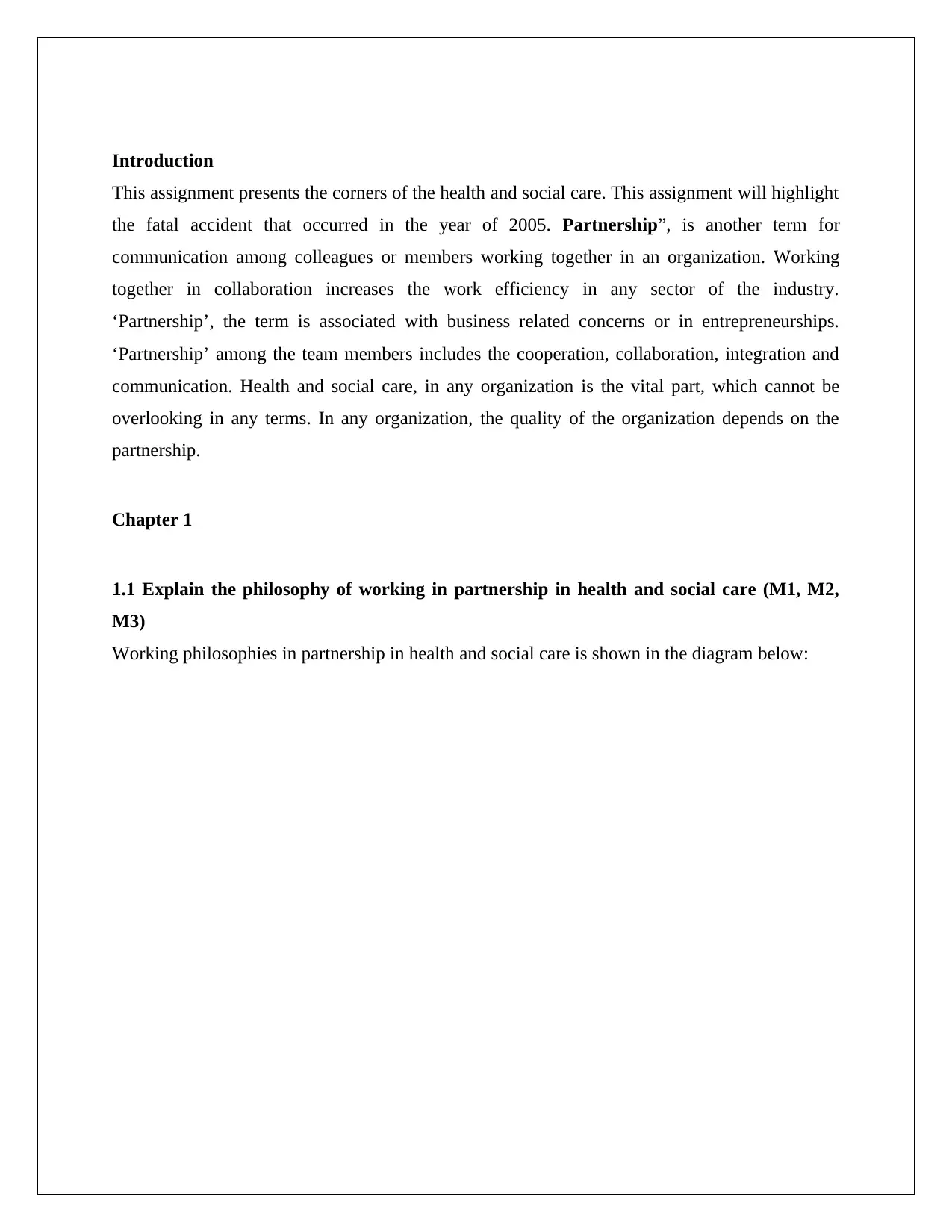
Introduction
This assignment presents the corners of the health and social care. This assignment will highlight
the fatal accident that occurred in the year of 2005. Partnership”, is another term for
communication among colleagues or members working together in an organization. Working
together in collaboration increases the work efficiency in any sector of the industry.
‘Partnership’, the term is associated with business related concerns or in entrepreneurships.
‘Partnership’ among the team members includes the cooperation, collaboration, integration and
communication. Health and social care, in any organization is the vital part, which cannot be
overlooking in any terms. In any organization, the quality of the organization depends on the
partnership.
Chapter 1
1.1 Explain the philosophy of working in partnership in health and social care (M1, M2,
M3)
Working philosophies in partnership in health and social care is shown in the diagram below:
Philosophies
This assignment presents the corners of the health and social care. This assignment will highlight
the fatal accident that occurred in the year of 2005. Partnership”, is another term for
communication among colleagues or members working together in an organization. Working
together in collaboration increases the work efficiency in any sector of the industry.
‘Partnership’, the term is associated with business related concerns or in entrepreneurships.
‘Partnership’ among the team members includes the cooperation, collaboration, integration and
communication. Health and social care, in any organization is the vital part, which cannot be
overlooking in any terms. In any organization, the quality of the organization depends on the
partnership.
Chapter 1
1.1 Explain the philosophy of working in partnership in health and social care (M1, M2,
M3)
Working philosophies in partnership in health and social care is shown in the diagram below:
Philosophies
⊘ This is a preview!⊘
Do you want full access?
Subscribe today to unlock all pages.

Trusted by 1+ million students worldwide
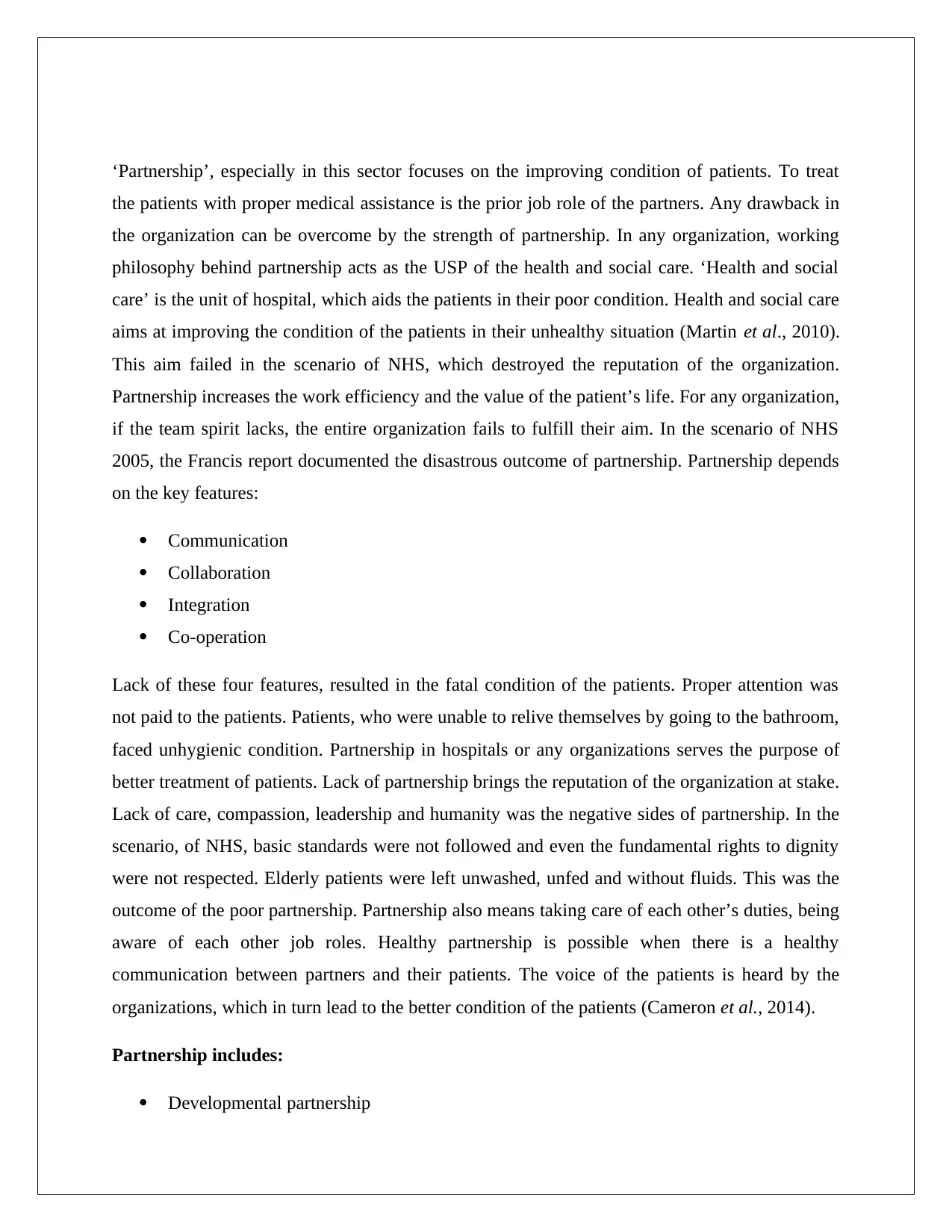
‘Partnership’, especially in this sector focuses on the improving condition of patients. To treat
the patients with proper medical assistance is the prior job role of the partners. Any drawback in
the organization can be overcome by the strength of partnership. In any organization, working
philosophy behind partnership acts as the USP of the health and social care. ‘Health and social
care’ is the unit of hospital, which aids the patients in their poor condition. Health and social care
aims at improving the condition of the patients in their unhealthy situation (Martin et al., 2010).
This aim failed in the scenario of NHS, which destroyed the reputation of the organization.
Partnership increases the work efficiency and the value of the patient’s life. For any organization,
if the team spirit lacks, the entire organization fails to fulfill their aim. In the scenario of NHS
2005, the Francis report documented the disastrous outcome of partnership. Partnership depends
on the key features:
Communication
Collaboration
Integration
Co-operation
Lack of these four features, resulted in the fatal condition of the patients. Proper attention was
not paid to the patients. Patients, who were unable to relive themselves by going to the bathroom,
faced unhygienic condition. Partnership in hospitals or any organizations serves the purpose of
better treatment of patients. Lack of partnership brings the reputation of the organization at stake.
Lack of care, compassion, leadership and humanity was the negative sides of partnership. In the
scenario, of NHS, basic standards were not followed and even the fundamental rights to dignity
were not respected. Elderly patients were left unwashed, unfed and without fluids. This was the
outcome of the poor partnership. Partnership also means taking care of each other’s duties, being
aware of each other job roles. Healthy partnership is possible when there is a healthy
communication between partners and their patients. The voice of the patients is heard by the
organizations, which in turn lead to the better condition of the patients (Cameron et al., 2014).
Partnership includes:
Developmental partnership
the patients with proper medical assistance is the prior job role of the partners. Any drawback in
the organization can be overcome by the strength of partnership. In any organization, working
philosophy behind partnership acts as the USP of the health and social care. ‘Health and social
care’ is the unit of hospital, which aids the patients in their poor condition. Health and social care
aims at improving the condition of the patients in their unhealthy situation (Martin et al., 2010).
This aim failed in the scenario of NHS, which destroyed the reputation of the organization.
Partnership increases the work efficiency and the value of the patient’s life. For any organization,
if the team spirit lacks, the entire organization fails to fulfill their aim. In the scenario of NHS
2005, the Francis report documented the disastrous outcome of partnership. Partnership depends
on the key features:
Communication
Collaboration
Integration
Co-operation
Lack of these four features, resulted in the fatal condition of the patients. Proper attention was
not paid to the patients. Patients, who were unable to relive themselves by going to the bathroom,
faced unhygienic condition. Partnership in hospitals or any organizations serves the purpose of
better treatment of patients. Lack of partnership brings the reputation of the organization at stake.
Lack of care, compassion, leadership and humanity was the negative sides of partnership. In the
scenario, of NHS, basic standards were not followed and even the fundamental rights to dignity
were not respected. Elderly patients were left unwashed, unfed and without fluids. This was the
outcome of the poor partnership. Partnership also means taking care of each other’s duties, being
aware of each other job roles. Healthy partnership is possible when there is a healthy
communication between partners and their patients. The voice of the patients is heard by the
organizations, which in turn lead to the better condition of the patients (Cameron et al., 2014).
Partnership includes:
Developmental partnership
Paraphrase This Document
Need a fresh take? Get an instant paraphrase of this document with our AI Paraphraser
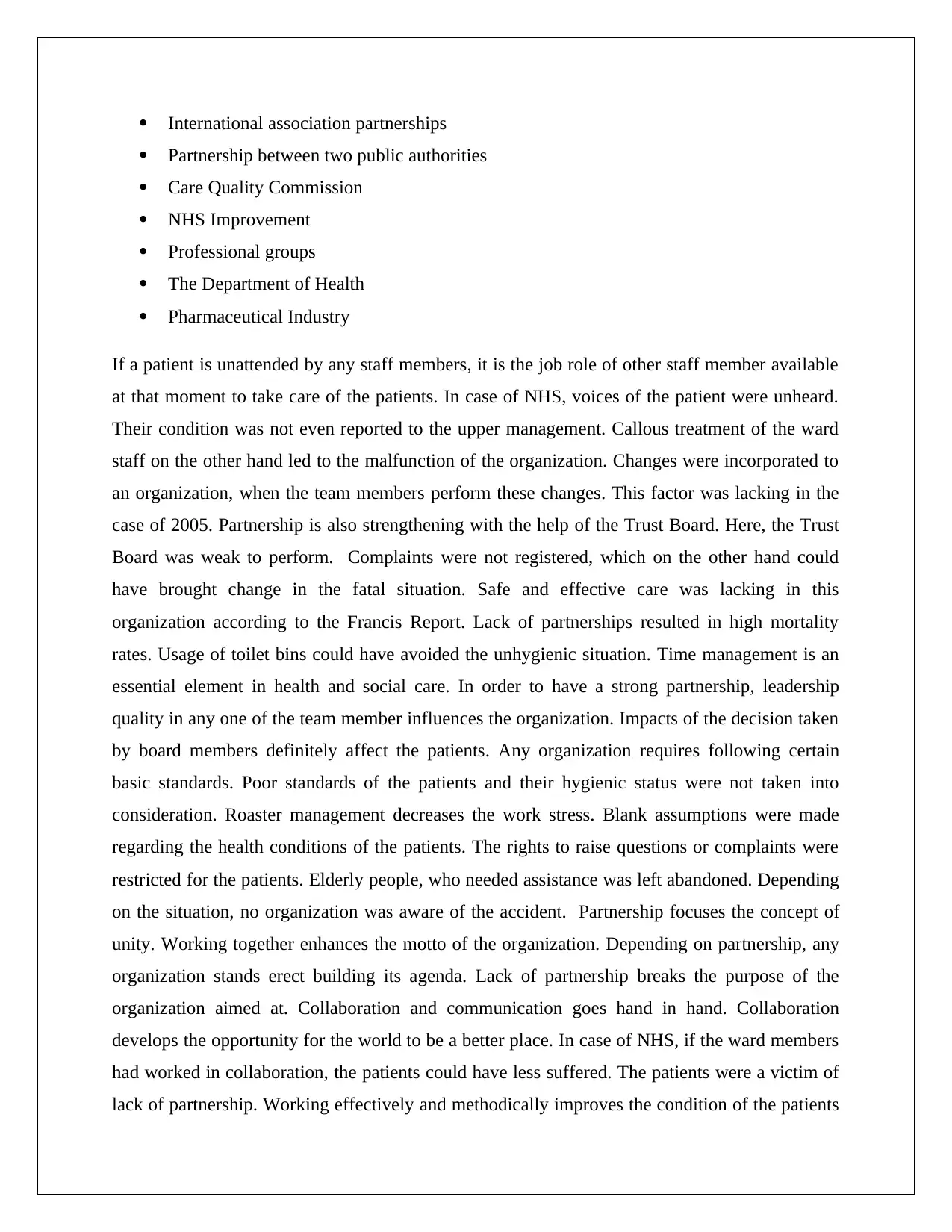
International association partnerships
Partnership between two public authorities
Care Quality Commission
NHS Improvement
Professional groups
The Department of Health
Pharmaceutical Industry
If a patient is unattended by any staff members, it is the job role of other staff member available
at that moment to take care of the patients. In case of NHS, voices of the patient were unheard.
Their condition was not even reported to the upper management. Callous treatment of the ward
staff on the other hand led to the malfunction of the organization. Changes were incorporated to
an organization, when the team members perform these changes. This factor was lacking in the
case of 2005. Partnership is also strengthening with the help of the Trust Board. Here, the Trust
Board was weak to perform. Complaints were not registered, which on the other hand could
have brought change in the fatal situation. Safe and effective care was lacking in this
organization according to the Francis Report. Lack of partnerships resulted in high mortality
rates. Usage of toilet bins could have avoided the unhygienic situation. Time management is an
essential element in health and social care. In order to have a strong partnership, leadership
quality in any one of the team member influences the organization. Impacts of the decision taken
by board members definitely affect the patients. Any organization requires following certain
basic standards. Poor standards of the patients and their hygienic status were not taken into
consideration. Roaster management decreases the work stress. Blank assumptions were made
regarding the health conditions of the patients. The rights to raise questions or complaints were
restricted for the patients. Elderly people, who needed assistance was left abandoned. Depending
on the situation, no organization was aware of the accident. Partnership focuses the concept of
unity. Working together enhances the motto of the organization. Depending on partnership, any
organization stands erect building its agenda. Lack of partnership breaks the purpose of the
organization aimed at. Collaboration and communication goes hand in hand. Collaboration
develops the opportunity for the world to be a better place. In case of NHS, if the ward members
had worked in collaboration, the patients could have less suffered. The patients were a victim of
lack of partnership. Working effectively and methodically improves the condition of the patients
Partnership between two public authorities
Care Quality Commission
NHS Improvement
Professional groups
The Department of Health
Pharmaceutical Industry
If a patient is unattended by any staff members, it is the job role of other staff member available
at that moment to take care of the patients. In case of NHS, voices of the patient were unheard.
Their condition was not even reported to the upper management. Callous treatment of the ward
staff on the other hand led to the malfunction of the organization. Changes were incorporated to
an organization, when the team members perform these changes. This factor was lacking in the
case of 2005. Partnership is also strengthening with the help of the Trust Board. Here, the Trust
Board was weak to perform. Complaints were not registered, which on the other hand could
have brought change in the fatal situation. Safe and effective care was lacking in this
organization according to the Francis Report. Lack of partnerships resulted in high mortality
rates. Usage of toilet bins could have avoided the unhygienic situation. Time management is an
essential element in health and social care. In order to have a strong partnership, leadership
quality in any one of the team member influences the organization. Impacts of the decision taken
by board members definitely affect the patients. Any organization requires following certain
basic standards. Poor standards of the patients and their hygienic status were not taken into
consideration. Roaster management decreases the work stress. Blank assumptions were made
regarding the health conditions of the patients. The rights to raise questions or complaints were
restricted for the patients. Elderly people, who needed assistance was left abandoned. Depending
on the situation, no organization was aware of the accident. Partnership focuses the concept of
unity. Working together enhances the motto of the organization. Depending on partnership, any
organization stands erect building its agenda. Lack of partnership breaks the purpose of the
organization aimed at. Collaboration and communication goes hand in hand. Collaboration
develops the opportunity for the world to be a better place. In case of NHS, if the ward members
had worked in collaboration, the patients could have less suffered. The patients were a victim of
lack of partnership. Working effectively and methodically improves the condition of the patients
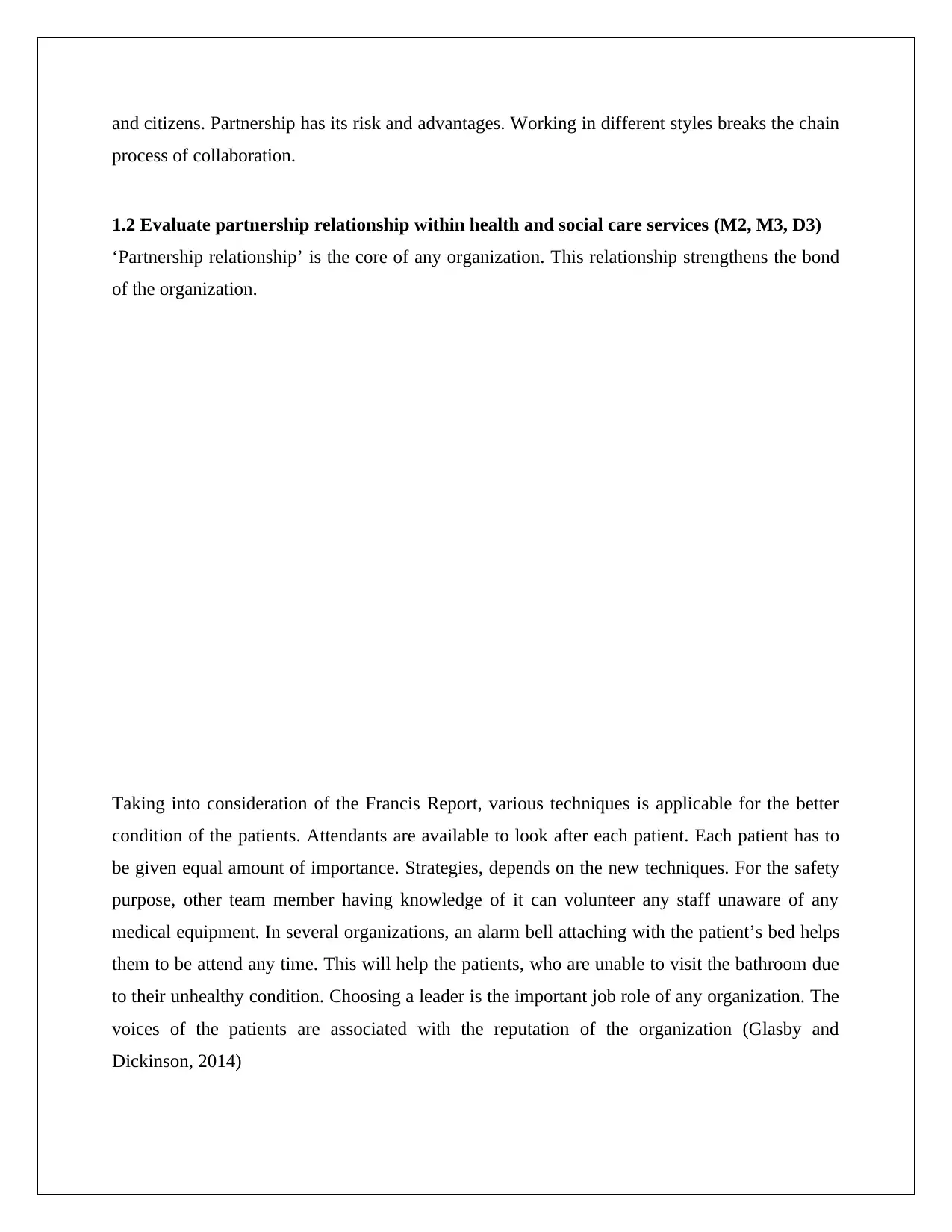
and citizens. Partnership has its risk and advantages. Working in different styles breaks the chain
process of collaboration.
1.2 Evaluate partnership relationship within health and social care services (M2, M3, D3)
‘Partnership relationship’ is the core of any organization. This relationship strengthens the bond
of the organization.
Taking into consideration of the Francis Report, various techniques is applicable for the better
condition of the patients. Attendants are available to look after each patient. Each patient has to
be given equal amount of importance. Strategies, depends on the new techniques. For the safety
purpose, other team member having knowledge of it can volunteer any staff unaware of any
medical equipment. In several organizations, an alarm bell attaching with the patient’s bed helps
them to be attend any time. This will help the patients, who are unable to visit the bathroom due
to their unhealthy condition. Choosing a leader is the important job role of any organization. The
voices of the patients are associated with the reputation of the organization (Glasby and
Dickinson, 2014)
EthicalPrinciples
process of collaboration.
1.2 Evaluate partnership relationship within health and social care services (M2, M3, D3)
‘Partnership relationship’ is the core of any organization. This relationship strengthens the bond
of the organization.
Taking into consideration of the Francis Report, various techniques is applicable for the better
condition of the patients. Attendants are available to look after each patient. Each patient has to
be given equal amount of importance. Strategies, depends on the new techniques. For the safety
purpose, other team member having knowledge of it can volunteer any staff unaware of any
medical equipment. In several organizations, an alarm bell attaching with the patient’s bed helps
them to be attend any time. This will help the patients, who are unable to visit the bathroom due
to their unhealthy condition. Choosing a leader is the important job role of any organization. The
voices of the patients are associated with the reputation of the organization (Glasby and
Dickinson, 2014)
EthicalPrinciples
⊘ This is a preview!⊘
Do you want full access?
Subscribe today to unlock all pages.

Trusted by 1+ million students worldwide
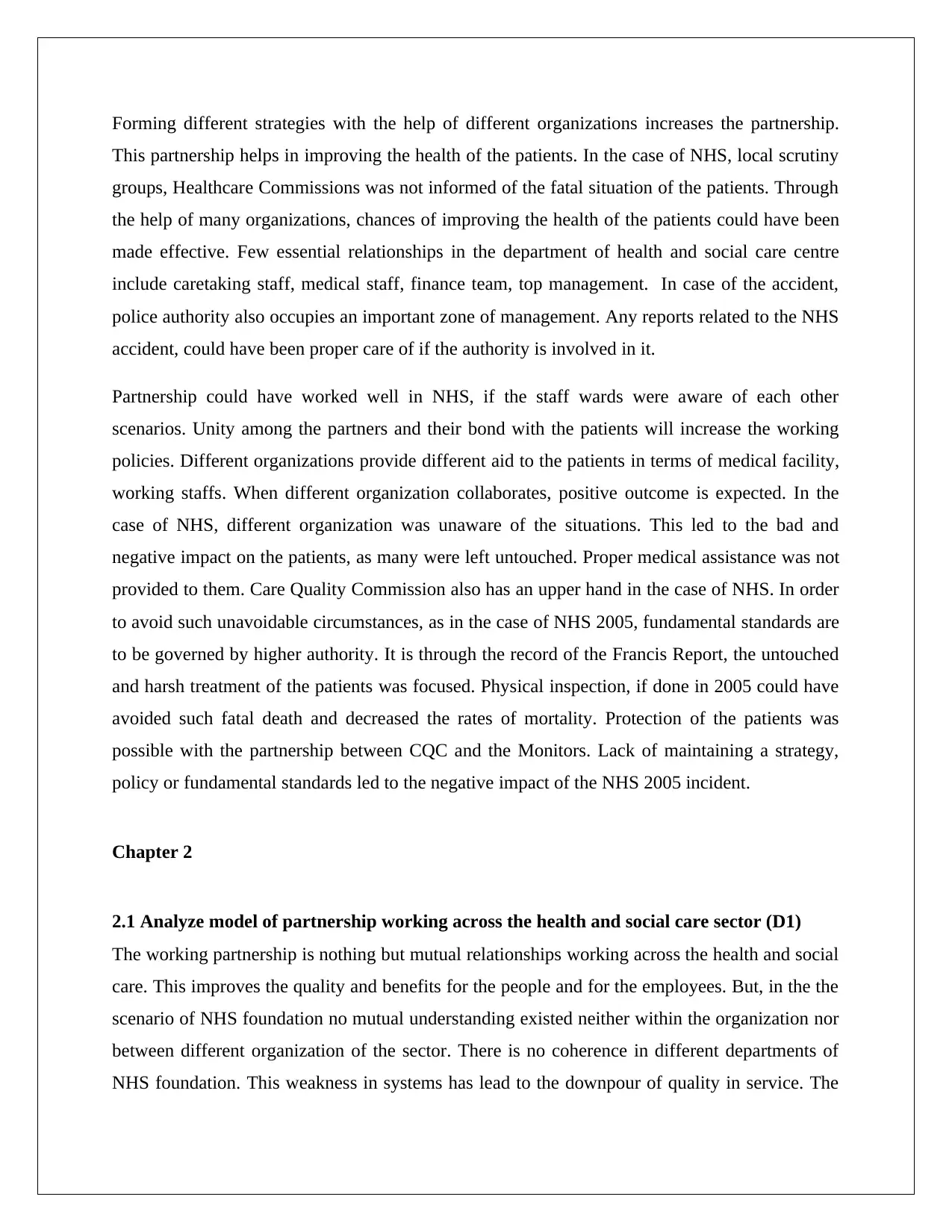
Forming different strategies with the help of different organizations increases the partnership.
This partnership helps in improving the health of the patients. In the case of NHS, local scrutiny
groups, Healthcare Commissions was not informed of the fatal situation of the patients. Through
the help of many organizations, chances of improving the health of the patients could have been
made effective. Few essential relationships in the department of health and social care centre
include caretaking staff, medical staff, finance team, top management. In case of the accident,
police authority also occupies an important zone of management. Any reports related to the NHS
accident, could have been proper care of if the authority is involved in it.
Partnership could have worked well in NHS, if the staff wards were aware of each other
scenarios. Unity among the partners and their bond with the patients will increase the working
policies. Different organizations provide different aid to the patients in terms of medical facility,
working staffs. When different organization collaborates, positive outcome is expected. In the
case of NHS, different organization was unaware of the situations. This led to the bad and
negative impact on the patients, as many were left untouched. Proper medical assistance was not
provided to them. Care Quality Commission also has an upper hand in the case of NHS. In order
to avoid such unavoidable circumstances, as in the case of NHS 2005, fundamental standards are
to be governed by higher authority. It is through the record of the Francis Report, the untouched
and harsh treatment of the patients was focused. Physical inspection, if done in 2005 could have
avoided such fatal death and decreased the rates of mortality. Protection of the patients was
possible with the partnership between CQC and the Monitors. Lack of maintaining a strategy,
policy or fundamental standards led to the negative impact of the NHS 2005 incident.
Chapter 2
2.1 Analyze model of partnership working across the health and social care sector (D1)
The working partnership is nothing but mutual relationships working across the health and social
care. This improves the quality and benefits for the people and for the employees. But, in the the
scenario of NHS foundation no mutual understanding existed neither within the organization nor
between different organization of the sector. There is no coherence in different departments of
NHS foundation. This weakness in systems has lead to the downpour of quality in service. The
This partnership helps in improving the health of the patients. In the case of NHS, local scrutiny
groups, Healthcare Commissions was not informed of the fatal situation of the patients. Through
the help of many organizations, chances of improving the health of the patients could have been
made effective. Few essential relationships in the department of health and social care centre
include caretaking staff, medical staff, finance team, top management. In case of the accident,
police authority also occupies an important zone of management. Any reports related to the NHS
accident, could have been proper care of if the authority is involved in it.
Partnership could have worked well in NHS, if the staff wards were aware of each other
scenarios. Unity among the partners and their bond with the patients will increase the working
policies. Different organizations provide different aid to the patients in terms of medical facility,
working staffs. When different organization collaborates, positive outcome is expected. In the
case of NHS, different organization was unaware of the situations. This led to the bad and
negative impact on the patients, as many were left untouched. Proper medical assistance was not
provided to them. Care Quality Commission also has an upper hand in the case of NHS. In order
to avoid such unavoidable circumstances, as in the case of NHS 2005, fundamental standards are
to be governed by higher authority. It is through the record of the Francis Report, the untouched
and harsh treatment of the patients was focused. Physical inspection, if done in 2005 could have
avoided such fatal death and decreased the rates of mortality. Protection of the patients was
possible with the partnership between CQC and the Monitors. Lack of maintaining a strategy,
policy or fundamental standards led to the negative impact of the NHS 2005 incident.
Chapter 2
2.1 Analyze model of partnership working across the health and social care sector (D1)
The working partnership is nothing but mutual relationships working across the health and social
care. This improves the quality and benefits for the people and for the employees. But, in the the
scenario of NHS foundation no mutual understanding existed neither within the organization nor
between different organization of the sector. There is no coherence in different departments of
NHS foundation. This weakness in systems has lead to the downpour of quality in service. The
Paraphrase This Document
Need a fresh take? Get an instant paraphrase of this document with our AI Paraphraser
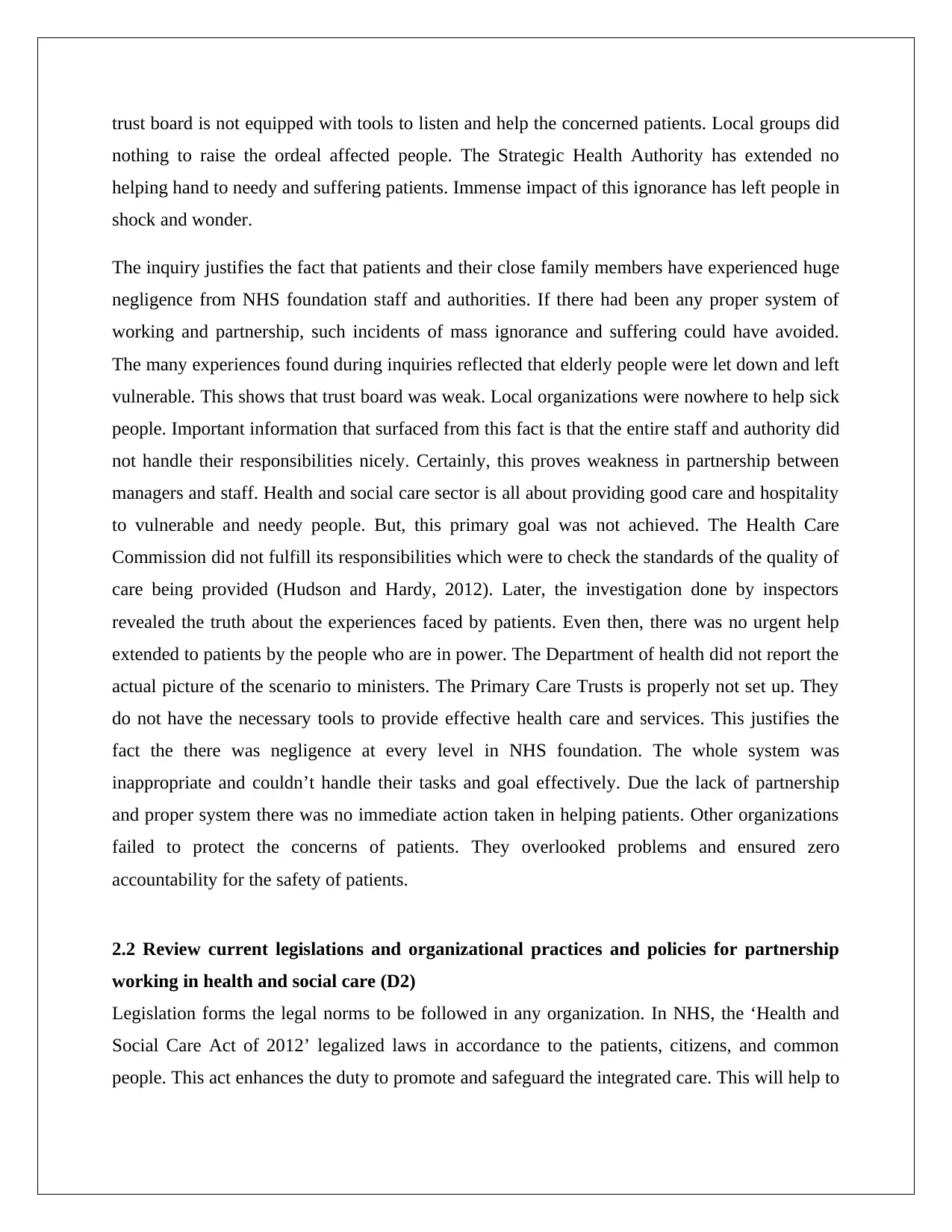
trust board is not equipped with tools to listen and help the concerned patients. Local groups did
nothing to raise the ordeal affected people. The Strategic Health Authority has extended no
helping hand to needy and suffering patients. Immense impact of this ignorance has left people in
shock and wonder.
The inquiry justifies the fact that patients and their close family members have experienced huge
negligence from NHS foundation staff and authorities. If there had been any proper system of
working and partnership, such incidents of mass ignorance and suffering could have avoided.
The many experiences found during inquiries reflected that elderly people were let down and left
vulnerable. This shows that trust board was weak. Local organizations were nowhere to help sick
people. Important information that surfaced from this fact is that the entire staff and authority did
not handle their responsibilities nicely. Certainly, this proves weakness in partnership between
managers and staff. Health and social care sector is all about providing good care and hospitality
to vulnerable and needy people. But, this primary goal was not achieved. The Health Care
Commission did not fulfill its responsibilities which were to check the standards of the quality of
care being provided (Hudson and Hardy, 2012). Later, the investigation done by inspectors
revealed the truth about the experiences faced by patients. Even then, there was no urgent help
extended to patients by the people who are in power. The Department of health did not report the
actual picture of the scenario to ministers. The Primary Care Trusts is properly not set up. They
do not have the necessary tools to provide effective health care and services. This justifies the
fact the there was negligence at every level in NHS foundation. The whole system was
inappropriate and couldn’t handle their tasks and goal effectively. Due the lack of partnership
and proper system there was no immediate action taken in helping patients. Other organizations
failed to protect the concerns of patients. They overlooked problems and ensured zero
accountability for the safety of patients.
2.2 Review current legislations and organizational practices and policies for partnership
working in health and social care (D2)
Legislation forms the legal norms to be followed in any organization. In NHS, the ‘Health and
Social Care Act of 2012’ legalized laws in accordance to the patients, citizens, and common
people. This act enhances the duty to promote and safeguard the integrated care. This will help to
nothing to raise the ordeal affected people. The Strategic Health Authority has extended no
helping hand to needy and suffering patients. Immense impact of this ignorance has left people in
shock and wonder.
The inquiry justifies the fact that patients and their close family members have experienced huge
negligence from NHS foundation staff and authorities. If there had been any proper system of
working and partnership, such incidents of mass ignorance and suffering could have avoided.
The many experiences found during inquiries reflected that elderly people were let down and left
vulnerable. This shows that trust board was weak. Local organizations were nowhere to help sick
people. Important information that surfaced from this fact is that the entire staff and authority did
not handle their responsibilities nicely. Certainly, this proves weakness in partnership between
managers and staff. Health and social care sector is all about providing good care and hospitality
to vulnerable and needy people. But, this primary goal was not achieved. The Health Care
Commission did not fulfill its responsibilities which were to check the standards of the quality of
care being provided (Hudson and Hardy, 2012). Later, the investigation done by inspectors
revealed the truth about the experiences faced by patients. Even then, there was no urgent help
extended to patients by the people who are in power. The Department of health did not report the
actual picture of the scenario to ministers. The Primary Care Trusts is properly not set up. They
do not have the necessary tools to provide effective health care and services. This justifies the
fact the there was negligence at every level in NHS foundation. The whole system was
inappropriate and couldn’t handle their tasks and goal effectively. Due the lack of partnership
and proper system there was no immediate action taken in helping patients. Other organizations
failed to protect the concerns of patients. They overlooked problems and ensured zero
accountability for the safety of patients.
2.2 Review current legislations and organizational practices and policies for partnership
working in health and social care (D2)
Legislation forms the legal norms to be followed in any organization. In NHS, the ‘Health and
Social Care Act of 2012’ legalized laws in accordance to the patients, citizens, and common
people. This act enhances the duty to promote and safeguard the integrated care. This will help to
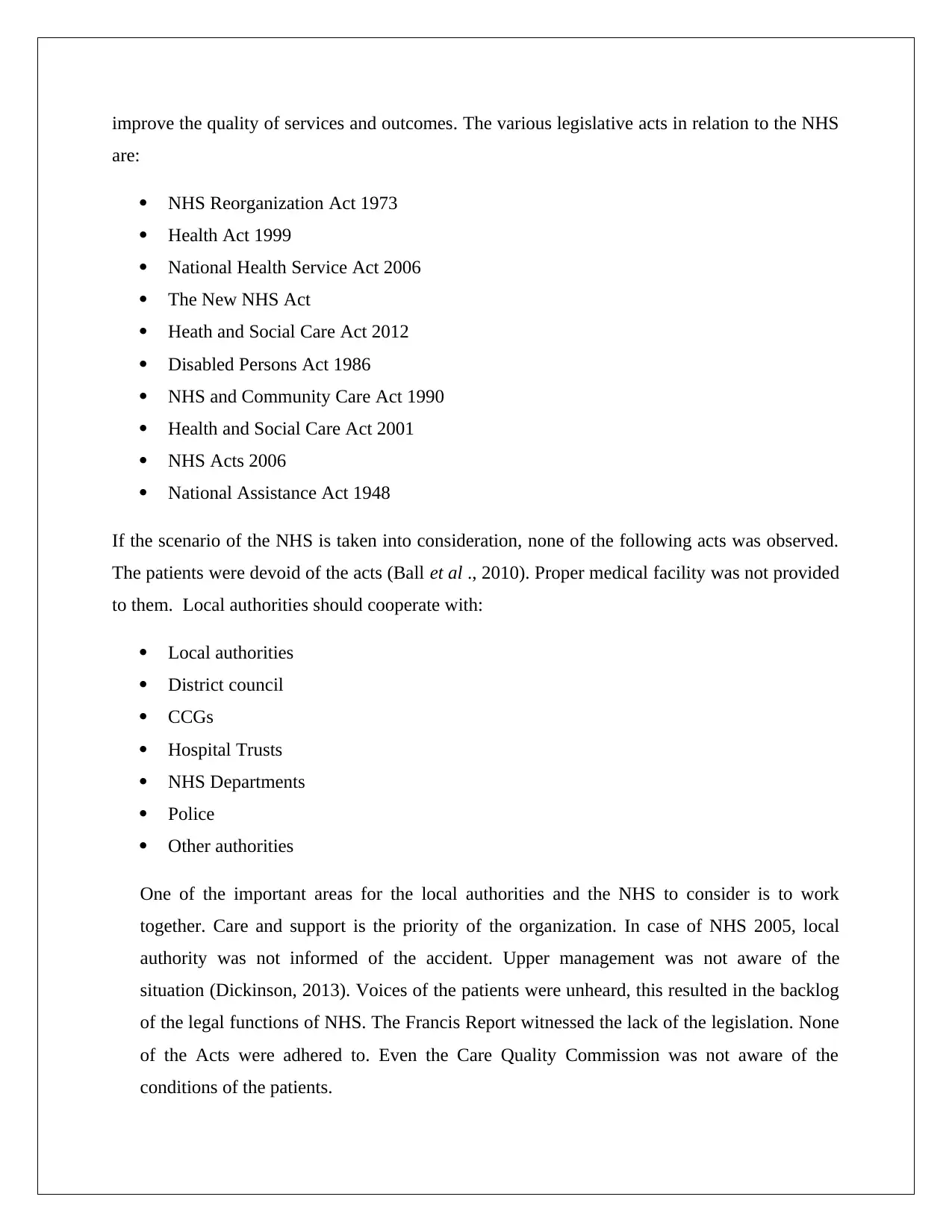
improve the quality of services and outcomes. The various legislative acts in relation to the NHS
are:
NHS Reorganization Act 1973
Health Act 1999
National Health Service Act 2006
The New NHS Act
Heath and Social Care Act 2012
Disabled Persons Act 1986
NHS and Community Care Act 1990
Health and Social Care Act 2001
NHS Acts 2006
National Assistance Act 1948
If the scenario of the NHS is taken into consideration, none of the following acts was observed.
The patients were devoid of the acts (Ball et al ., 2010). Proper medical facility was not provided
to them. Local authorities should cooperate with:
Local authorities
District council
CCGs
Hospital Trusts
NHS Departments
Police
Other authorities
One of the important areas for the local authorities and the NHS to consider is to work
together. Care and support is the priority of the organization. In case of NHS 2005, local
authority was not informed of the accident. Upper management was not aware of the
situation (Dickinson, 2013). Voices of the patients were unheard, this resulted in the backlog
of the legal functions of NHS. The Francis Report witnessed the lack of the legislation. None
of the Acts were adhered to. Even the Care Quality Commission was not aware of the
conditions of the patients.
are:
NHS Reorganization Act 1973
Health Act 1999
National Health Service Act 2006
The New NHS Act
Heath and Social Care Act 2012
Disabled Persons Act 1986
NHS and Community Care Act 1990
Health and Social Care Act 2001
NHS Acts 2006
National Assistance Act 1948
If the scenario of the NHS is taken into consideration, none of the following acts was observed.
The patients were devoid of the acts (Ball et al ., 2010). Proper medical facility was not provided
to them. Local authorities should cooperate with:
Local authorities
District council
CCGs
Hospital Trusts
NHS Departments
Police
Other authorities
One of the important areas for the local authorities and the NHS to consider is to work
together. Care and support is the priority of the organization. In case of NHS 2005, local
authority was not informed of the accident. Upper management was not aware of the
situation (Dickinson, 2013). Voices of the patients were unheard, this resulted in the backlog
of the legal functions of NHS. The Francis Report witnessed the lack of the legislation. None
of the Acts were adhered to. Even the Care Quality Commission was not aware of the
conditions of the patients.
⊘ This is a preview!⊘
Do you want full access?
Subscribe today to unlock all pages.

Trusted by 1+ million students worldwide
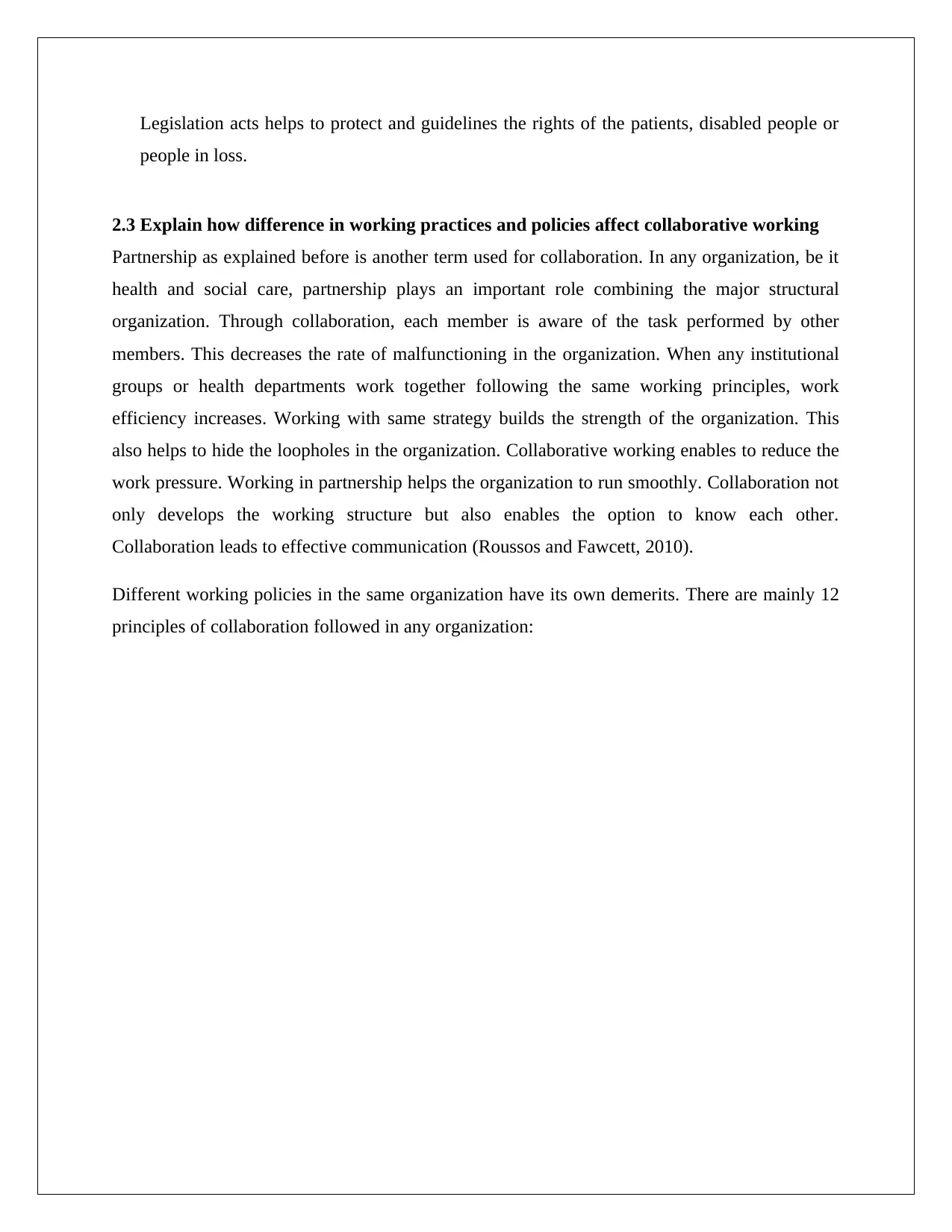
Legislation acts helps to protect and guidelines the rights of the patients, disabled people or
people in loss.
2.3 Explain how difference in working practices and policies affect collaborative working
Partnership as explained before is another term used for collaboration. In any organization, be it
health and social care, partnership plays an important role combining the major structural
organization. Through collaboration, each member is aware of the task performed by other
members. This decreases the rate of malfunctioning in the organization. When any institutional
groups or health departments work together following the same working principles, work
efficiency increases. Working with same strategy builds the strength of the organization. This
also helps to hide the loopholes in the organization. Collaborative working enables to reduce the
work pressure. Working in partnership helps the organization to run smoothly. Collaboration not
only develops the working structure but also enables the option to know each other.
Collaboration leads to effective communication (Roussos and Fawcett, 2010).
Different working policies in the same organization have its own demerits. There are mainly 12
principles of collaboration followed in any organization:
CollaborationIndividualbenefitStrategybeforetechnologyVoiceoftheemployeeLearntogetoutofwayLeadbyexampleCollaborationmakestheworldabetterplace
people in loss.
2.3 Explain how difference in working practices and policies affect collaborative working
Partnership as explained before is another term used for collaboration. In any organization, be it
health and social care, partnership plays an important role combining the major structural
organization. Through collaboration, each member is aware of the task performed by other
members. This decreases the rate of malfunctioning in the organization. When any institutional
groups or health departments work together following the same working principles, work
efficiency increases. Working with same strategy builds the strength of the organization. This
also helps to hide the loopholes in the organization. Collaborative working enables to reduce the
work pressure. Working in partnership helps the organization to run smoothly. Collaboration not
only develops the working structure but also enables the option to know each other.
Collaboration leads to effective communication (Roussos and Fawcett, 2010).
Different working policies in the same organization have its own demerits. There are mainly 12
principles of collaboration followed in any organization:
CollaborationIndividualbenefitStrategybeforetechnologyVoiceoftheemployeeLearntogetoutofwayLeadbyexampleCollaborationmakestheworldabetterplace
Paraphrase This Document
Need a fresh take? Get an instant paraphrase of this document with our AI Paraphraser
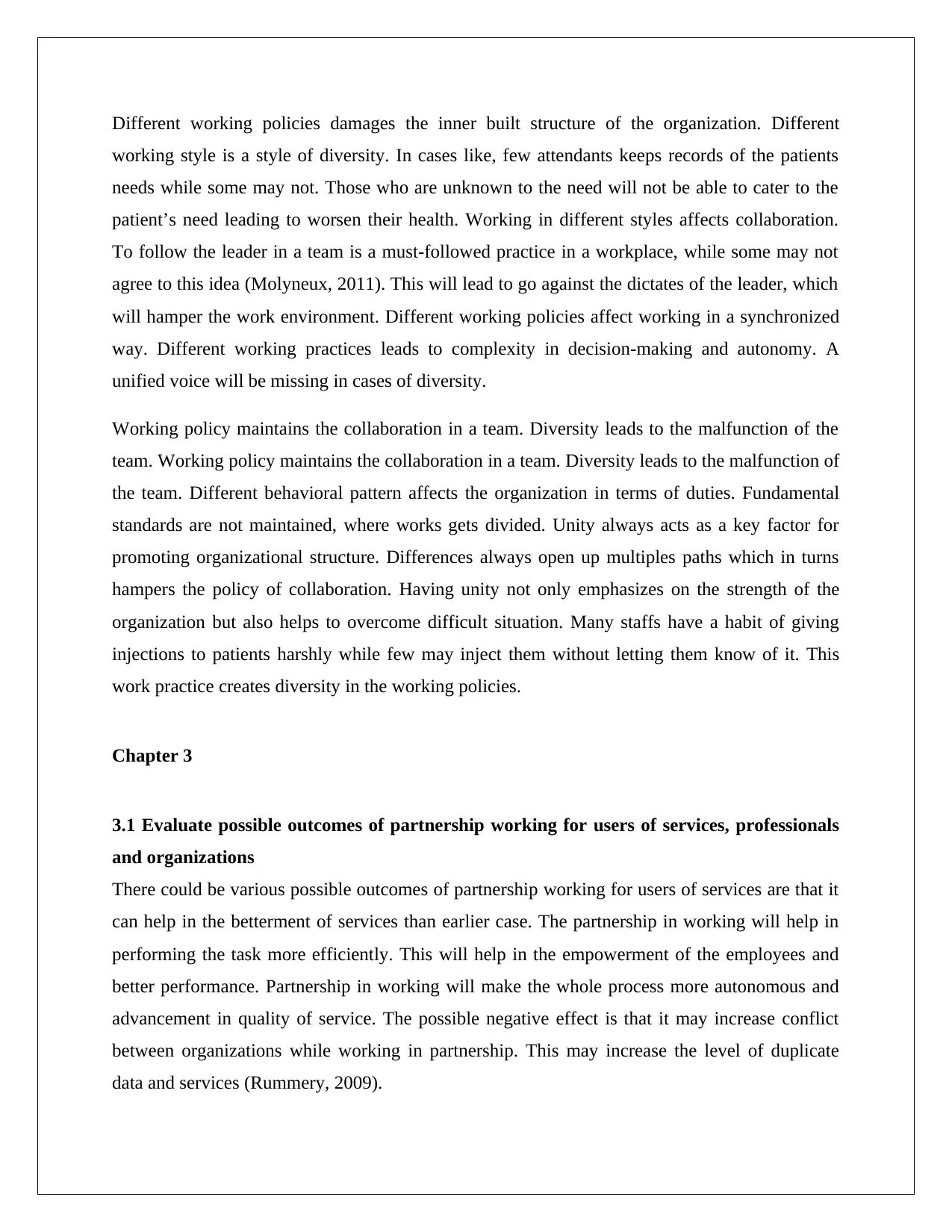
Different working policies damages the inner built structure of the organization. Different
working style is a style of diversity. In cases like, few attendants keeps records of the patients
needs while some may not. Those who are unknown to the need will not be able to cater to the
patient’s need leading to worsen their health. Working in different styles affects collaboration.
To follow the leader in a team is a must-followed practice in a workplace, while some may not
agree to this idea (Molyneux, 2011). This will lead to go against the dictates of the leader, which
will hamper the work environment. Different working policies affect working in a synchronized
way. Different working practices leads to complexity in decision-making and autonomy. A
unified voice will be missing in cases of diversity.
Working policy maintains the collaboration in a team. Diversity leads to the malfunction of the
team. Working policy maintains the collaboration in a team. Diversity leads to the malfunction of
the team. Different behavioral pattern affects the organization in terms of duties. Fundamental
standards are not maintained, where works gets divided. Unity always acts as a key factor for
promoting organizational structure. Differences always open up multiples paths which in turns
hampers the policy of collaboration. Having unity not only emphasizes on the strength of the
organization but also helps to overcome difficult situation. Many staffs have a habit of giving
injections to patients harshly while few may inject them without letting them know of it. This
work practice creates diversity in the working policies.
Chapter 3
3.1 Evaluate possible outcomes of partnership working for users of services, professionals
and organizations
There could be various possible outcomes of partnership working for users of services are that it
can help in the betterment of services than earlier case. The partnership in working will help in
performing the task more efficiently. This will help in the empowerment of the employees and
better performance. Partnership in working will make the whole process more autonomous and
advancement in quality of service. The possible negative effect is that it may increase conflict
between organizations while working in partnership. This may increase the level of duplicate
data and services (Rummery, 2009).
working style is a style of diversity. In cases like, few attendants keeps records of the patients
needs while some may not. Those who are unknown to the need will not be able to cater to the
patient’s need leading to worsen their health. Working in different styles affects collaboration.
To follow the leader in a team is a must-followed practice in a workplace, while some may not
agree to this idea (Molyneux, 2011). This will lead to go against the dictates of the leader, which
will hamper the work environment. Different working policies affect working in a synchronized
way. Different working practices leads to complexity in decision-making and autonomy. A
unified voice will be missing in cases of diversity.
Working policy maintains the collaboration in a team. Diversity leads to the malfunction of the
team. Working policy maintains the collaboration in a team. Diversity leads to the malfunction of
the team. Different behavioral pattern affects the organization in terms of duties. Fundamental
standards are not maintained, where works gets divided. Unity always acts as a key factor for
promoting organizational structure. Differences always open up multiples paths which in turns
hampers the policy of collaboration. Having unity not only emphasizes on the strength of the
organization but also helps to overcome difficult situation. Many staffs have a habit of giving
injections to patients harshly while few may inject them without letting them know of it. This
work practice creates diversity in the working policies.
Chapter 3
3.1 Evaluate possible outcomes of partnership working for users of services, professionals
and organizations
There could be various possible outcomes of partnership working for users of services are that it
can help in the betterment of services than earlier case. The partnership in working will help in
performing the task more efficiently. This will help in the empowerment of the employees and
better performance. Partnership in working will make the whole process more autonomous and
advancement in quality of service. The possible negative effect is that it may increase conflict
between organizations while working in partnership. This may increase the level of duplicate
data and services (Rummery, 2009).
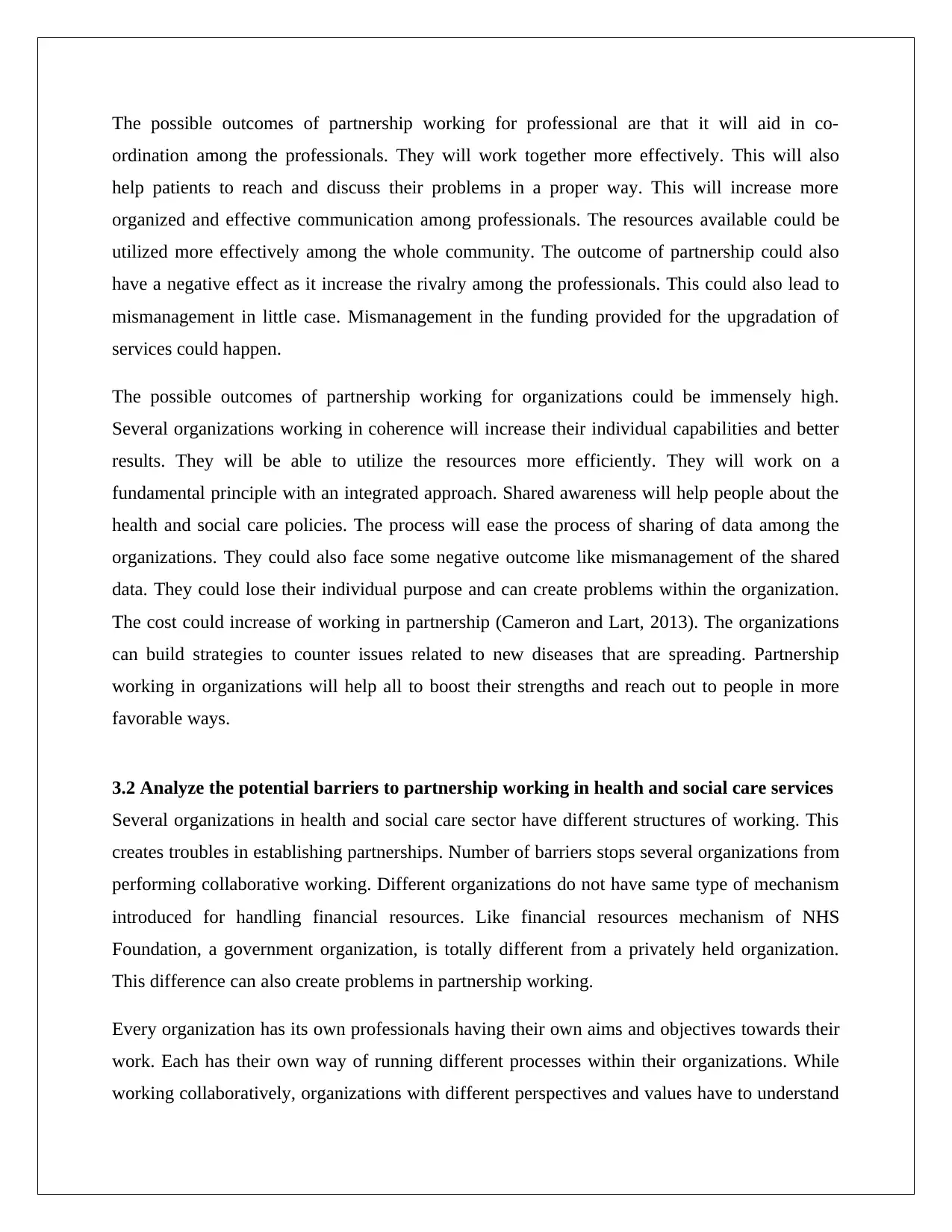
The possible outcomes of partnership working for professional are that it will aid in co-
ordination among the professionals. They will work together more effectively. This will also
help patients to reach and discuss their problems in a proper way. This will increase more
organized and effective communication among professionals. The resources available could be
utilized more effectively among the whole community. The outcome of partnership could also
have a negative effect as it increase the rivalry among the professionals. This could also lead to
mismanagement in little case. Mismanagement in the funding provided for the upgradation of
services could happen.
The possible outcomes of partnership working for organizations could be immensely high.
Several organizations working in coherence will increase their individual capabilities and better
results. They will be able to utilize the resources more efficiently. They will work on a
fundamental principle with an integrated approach. Shared awareness will help people about the
health and social care policies. The process will ease the process of sharing of data among the
organizations. They could also face some negative outcome like mismanagement of the shared
data. They could lose their individual purpose and can create problems within the organization.
The cost could increase of working in partnership (Cameron and Lart, 2013). The organizations
can build strategies to counter issues related to new diseases that are spreading. Partnership
working in organizations will help all to boost their strengths and reach out to people in more
favorable ways.
3.2 Analyze the potential barriers to partnership working in health and social care services
Several organizations in health and social care sector have different structures of working. This
creates troubles in establishing partnerships. Number of barriers stops several organizations from
performing collaborative working. Different organizations do not have same type of mechanism
introduced for handling financial resources. Like financial resources mechanism of NHS
Foundation, a government organization, is totally different from a privately held organization.
This difference can also create problems in partnership working.
Every organization has its own professionals having their own aims and objectives towards their
work. Each has their own way of running different processes within their organizations. While
working collaboratively, organizations with different perspectives and values have to understand
ordination among the professionals. They will work together more effectively. This will also
help patients to reach and discuss their problems in a proper way. This will increase more
organized and effective communication among professionals. The resources available could be
utilized more effectively among the whole community. The outcome of partnership could also
have a negative effect as it increase the rivalry among the professionals. This could also lead to
mismanagement in little case. Mismanagement in the funding provided for the upgradation of
services could happen.
The possible outcomes of partnership working for organizations could be immensely high.
Several organizations working in coherence will increase their individual capabilities and better
results. They will be able to utilize the resources more efficiently. They will work on a
fundamental principle with an integrated approach. Shared awareness will help people about the
health and social care policies. The process will ease the process of sharing of data among the
organizations. They could also face some negative outcome like mismanagement of the shared
data. They could lose their individual purpose and can create problems within the organization.
The cost could increase of working in partnership (Cameron and Lart, 2013). The organizations
can build strategies to counter issues related to new diseases that are spreading. Partnership
working in organizations will help all to boost their strengths and reach out to people in more
favorable ways.
3.2 Analyze the potential barriers to partnership working in health and social care services
Several organizations in health and social care sector have different structures of working. This
creates troubles in establishing partnerships. Number of barriers stops several organizations from
performing collaborative working. Different organizations do not have same type of mechanism
introduced for handling financial resources. Like financial resources mechanism of NHS
Foundation, a government organization, is totally different from a privately held organization.
This difference can also create problems in partnership working.
Every organization has its own professionals having their own aims and objectives towards their
work. Each has their own way of running different processes within their organizations. While
working collaboratively, organizations with different perspectives and values have to understand
⊘ This is a preview!⊘
Do you want full access?
Subscribe today to unlock all pages.

Trusted by 1+ million students worldwide
1 out of 17
Related Documents
Your All-in-One AI-Powered Toolkit for Academic Success.
+13062052269
info@desklib.com
Available 24*7 on WhatsApp / Email
![[object Object]](/_next/static/media/star-bottom.7253800d.svg)
Unlock your academic potential
Copyright © 2020–2025 A2Z Services. All Rights Reserved. Developed and managed by ZUCOL.





